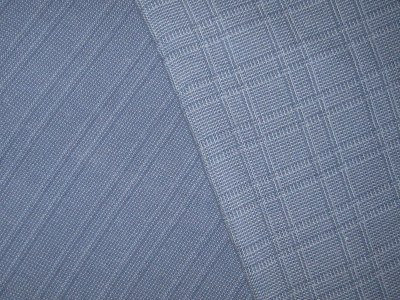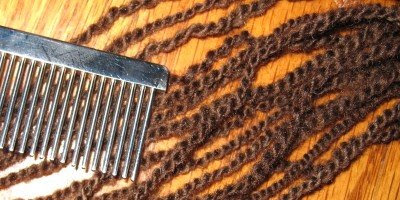By
LeighFor two weeks I've been wanting to tell you about this month's
Western North Carolina Fibers/Handweaver's Guild meeting. The program for April was "Sewing With Handwovens" with
Liz Spear. What an inspiration!
Liz started by telling us about her own journey into the world of weaving, creating, and marketing her own designer clothing. Then she shared many of the garment making tips she learned through her own experience, and answered all our questions. She also brought an entire garment rack of her own designs which we were able to see, touch, try on, and take a close look at.
Sewing was my introduction into the world of textiles. I learned how to sew in a mandatory home ec class in junior high, and absolutely loved it. I loved looking at fabrics, at threads, and at patterns. I loved creating my own designs and was forever combining sewing patterns to get what I wanted. All through high school I "designed" and made my own clothes. In fact, my mother encouraged me to apply to the Art Institute of Chicago to study clothing design. In those days however, I wasn't one to follow my mother's advice, but on this I sometimes wish I had.
Gradually I became interested in other fiber arts, going next to quilting and embroidery. Later, I sewed most of my daughter's clothing when she was little, doing a lot of smocking and embroidery on them. Spinning and weaving didn't come until she was in high school. Now, I occasionally sew for myself with commercial fabrics, but most of my time seems to go to weaving, spinning, knitting, and blogging. Of my own handwoven fabrics, I can pull out one vest (no photo), one necktie (
that post here), and a few bags
(click here to see those). But that's it.
Liz's program has made me think about why I've been reluctant to do more sewing with my handwovens. It's not as though I haven't woven yardage with the intention of sewing with it.....


Or that I don't have plenty of oddments and scraps to create with.....

Somehow I just don't feel confident enough to tackle it. One reason is knowledge, or rather lack of it. I've assumed that working with handwoven fabric requires special techniques. Another reason is that I've not always been satisfied with what I've created. Too often, the finished item didn't match the idea in my head. That's bad enough with boughten fabric, but with handwoven fabric?? It breaks my heart just to think about it. Then too, I'm reluctant because I never learned anything about fine sewing or tailoring. I can do basic garment construction from a pattern, with barely passable zippers and button holes. But that's about it. My inner sense tells me that handwoven cloth deserves the very best of all the details.
What I'm trying to get around to saying, is that Liz's program has equipped me with a new resolve to actually start sewing with my own fabrics. Like everything else, I realize that I'll never get started if I continue to think of reasons why I
can't do it. Like everything else, it starts with a decision and a first step. So, I've made the decision and am ready to take that first step. I've been researching sergers and thinking about getting one.
Please don't expect too many posts about my actually doing this. I may have found the resolve to take that first step, but I still have to get up the nerve to take the second one.
Related Posts:
Hemming Handwoven FabricsHow Do You Hem Your Handwovens?Serger Research & Decision
 I couldn't have done that with full size combs, but it works well with my minis. Here are the results:
I couldn't have done that with full size combs, but it works well with my minis. Here are the results: The alpaca is on the right, the Polwarth is in the middle. The alpaca, though brown, has a reddish cast. This blend had the nicest hand and was soft and silky to spin. Very lovely.
The alpaca is on the right, the Polwarth is in the middle. The alpaca, though brown, has a reddish cast. This blend had the nicest hand and was soft and silky to spin. Very lovely. Again, alpaca is on the right. A darker brown than the first one, but shorter than the Polwarth. Even so, the blend drafted fairly evenly off the comb. I like the color of the yarn, but it isn't as soft.
Again, alpaca is on the right. A darker brown than the first one, but shorter than the Polwarth. Even so, the blend drafted fairly evenly off the comb. I like the color of the yarn, but it isn't as soft. I blended some with cinnamon colored alpaca out of curiosity. The yarn has more interesting color depth, though that's hard to see in the above image. However, since I have more of the dark brown alpaca, I think I'd prefer to save this color for a project all on its own.
I blended some with cinnamon colored alpaca out of curiosity. The yarn has more interesting color depth, though that's hard to see in the above image. However, since I have more of the dark brown alpaca, I think I'd prefer to save this color for a project all on its own.

















